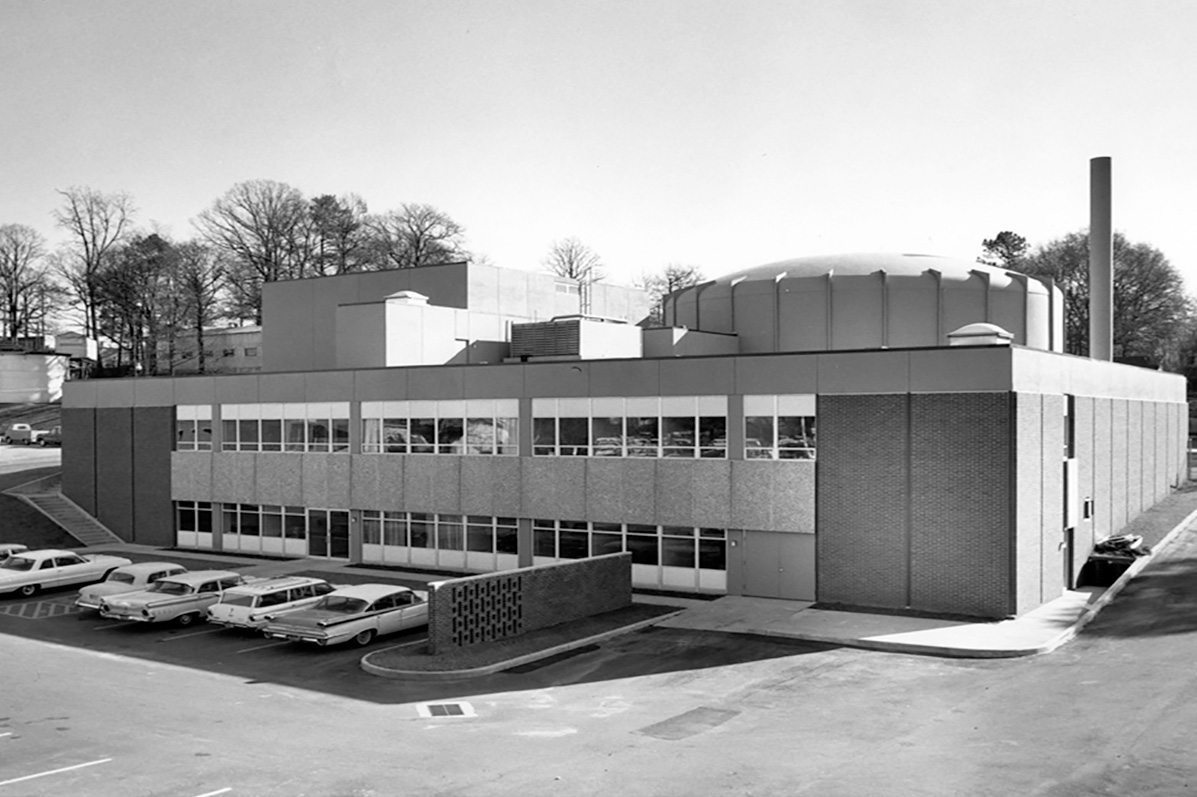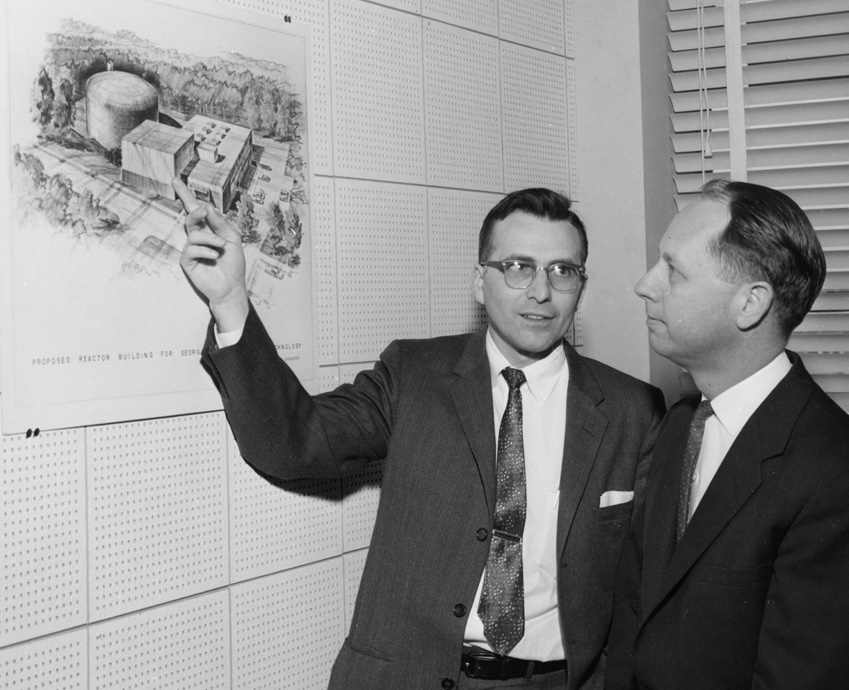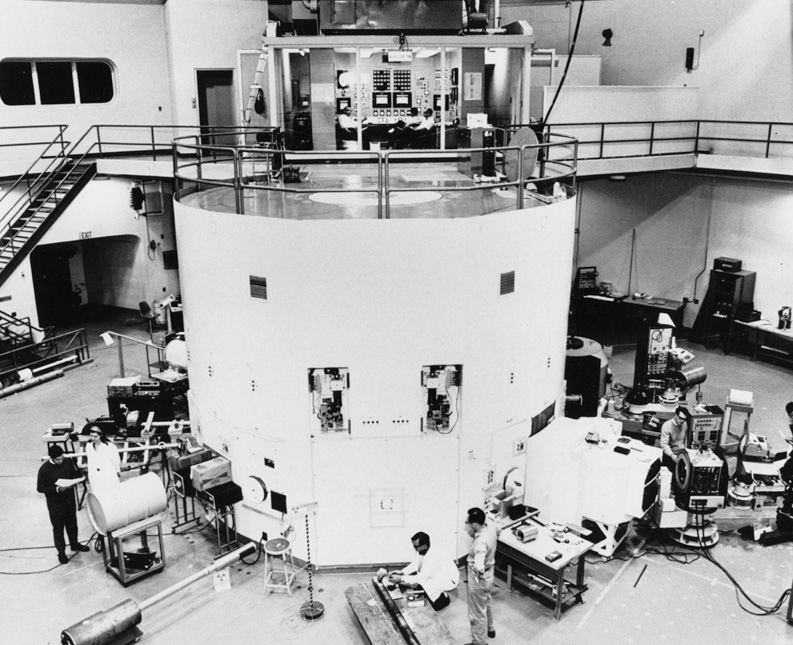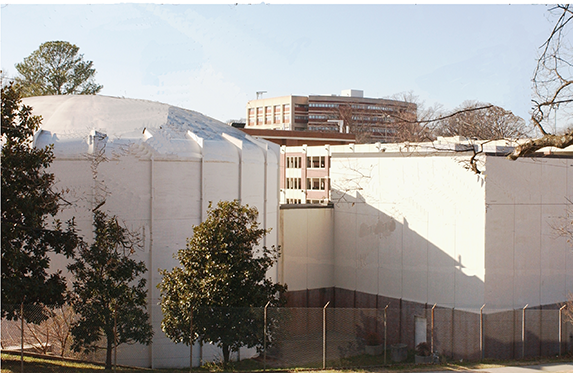
Neely Nuclear Research Center Named American Nuclear Society Nuclear Historic Landmark
November 10, 2025
By Tracie Troha
Georgia Tech’s former Neely Nuclear Research Center (NNRC) has been designated as an American Nuclear Society (ANS) Nuclear Historic Landmark in recognition of its nearly four decades of pioneering contributions to nuclear science, education, and technology. The NNRC operated from 1964 until its closure in 1995. The ANS Board of Directors approved the designation in September.
The ANS Nuclear Historic Landmark Award honors sites or facilities that played a pivotal role in advancing nuclear science and engineering. The NNRC will receive a bronze plaque that reads:
“The Neely Nuclear Research Center at Georgia Institute of Technology advanced nuclear science through its pioneering reactor design, biomedical applications, and training of generations of engineers. As a unique academic complex integrating reactor, radiochemistry, and irradiation capabilities, it played a transformative role in peaceful nuclear research.”
A Cornerstone of Nuclear Research
The NNRC housed the Georgia Tech Research Reactor (GTRR), a 5 MW D₂O-moderated and -cooled reactor designed by Walter Zinn, a key figure in the Manhattan Project and one of the founding pioneers of nuclear reactor design.
By providing an academic setting that integrated reactor operations, radiochemistry, materials testing, and biomedical applications, the NNRC was a training ground for generations of nuclear engineers, researchers, and medical physicists.
“[The NNRC] has played a pivotal role in the education and training of countless nuclear engineers—many of whom went on to contribute significantly to the expansion of the nuclear power utility industry in the United States,” said alumnus Dolan Falconer, B.S. NE 1978, M.S. NE 1979, a member of George W. Woodruff School of Mechanical Engineering’s Nuclear and Radiological Engineering and Medical Physics (NREMP) Advisory Board.
The Vision and Funding of the NNRC
The origins of the NNRC trace back to a 1956 meeting of Southern governors who wanted to bring nuclear science to the region. Georgia’s industrial leaders spearheaded the effort to build a research reactor at Georgia Tech.
Funding for the $4.5 million facility—the largest single building investment in Georgia Tech’s history at the time—came from the state of Georgia, the National Science Foundation, and the Atomic Energy Commission.
Construction began in 1960, and the reactor achieved first criticality on Dec. 31, 1964. The facility was named in honor of Frank H. Neely, a distinguished Georgia Tech alumnus, business leader, and longtime supporter of the Institute. The naming was a tribute to his vision for integrating science and industry and to his lifelong commitment to Georgia Tech as a trustee, alumnus, and civic leader.


Innovation in Science and Medicine
Beyond its engineering significance, the NNRC broke new ground in medical research. The center’s Boron Neutron Capture Therapy (BNCT) facility was at the forefront to explore neutron-based treatments for glioblastoma multiforme, an aggressive brain cancer.
The reactor’s medical irradiation room, equipped with a hydraulically actuated neutron beam collimator and bismuth gamma shield, exemplified the integration of nuclear technology with biomedical innovation.
“One of my colleagues, who served as the director of at least three different university research reactors, once referred to the GTRR facility as the Porsche of such facilities,” said Professor Emeritus Nolan Hertel.
A National Resource for Training and Research
As a training hub, the NNRC educated thousands of students in reactor physics, health physics, and radiochemistry. It also provided extensive services to national laboratories, medical institutions, and utility companies.
“The legacy of the NNRC lives on in the careers of its alumni and the technological advances it helped realize,” said NREMP Program Chair Steven Biegalski. “As someone who now leads the academic program it once physically anchored, I see daily the lasting impact it has had on our discipline and the high standard it set for integrated nuclear research infrastructure.”
Legacy and Decommissioning
The reactor’s closure coincided with preparations for the 1996 Atlanta Olympic Games, when security and logistical considerations led to the removal of its highly enriched uranium fuel. Although relicensed for low-enriched uranium operation, Georgia Tech decided to decommission the reactor in 1995. Its fuel was shipped offsite, and the building was eventually demolished to make way for the Marcus Nanotechnology Building.
A Lasting Tribute
The ANS Nuclear Historic Landmark designation affirms the NNRC’s significance in U.S. nuclear history and serves as a tribute to the scientists, engineers, and students who advanced peaceful applications of nuclear energy within its walls.
“Placement of the award plaque will serve as a permanent memorial to the reactor and the people who operated and utilized it in pursuit of expanded successful deployment of nuclear technology for the benefit of mankind,” said alumnus and NREMP advisory board member Kyle Turner, EE 1969, M.S. NE 1969, Ph.D. NE 1971.
Biegalski said the ANS president is expected to formally present the plaque to Georgia Tech in Spring 2026, with plans to potentially place a remembrance plaque at the former NNRC site.


